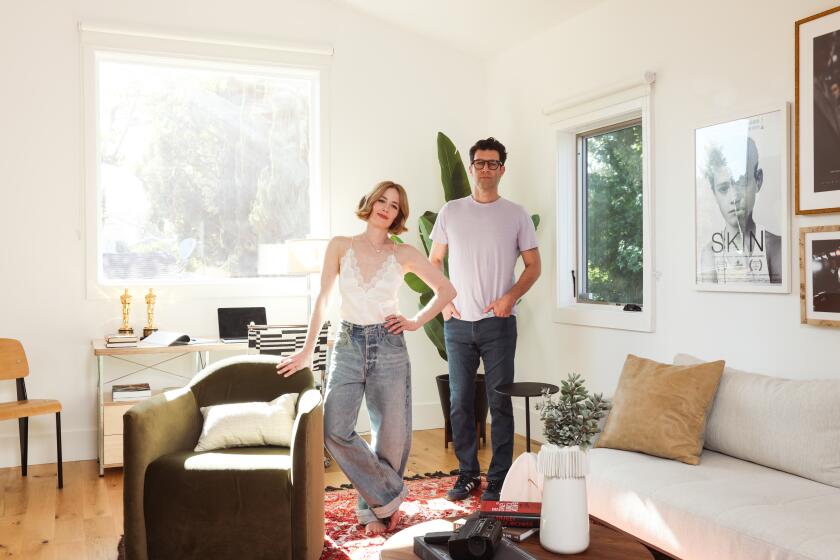South-Central is flowering
Jose Luna doesn’t see the blight around him in his neighborhood in Historic South-Central. That old apartment building with the shuttered windows? Not a problem. The graffiti on the sidewalk? He’s too busy building the home of his dreams to notice.
He’s not one to brag, so I’ll do it for him. Luna, a garment worker, has created a gorgeous front garden, by far the best-looking one on his block of Woodlawn Avenue.
The gnarled columns of an old cactus are the centerpiece. Rosebushes and begonias provide a flash of color. And in one corner there’s a bird of paradise that has a sentimental little story attached to it.
For Luna, a 42-year-old native of Mexico, owning a home is the proudest accomplishment of three decades in the United States. I look at his home and garden and see something more.
Over the years a lot of different kinds of people have brought this sort of determination to South-Central. It springs from the everyday pursuit of ordinary happiness, the relentless striving of unpretentious people for normal things.
L.A. history teaches us that when people leave South-Central for a “better” place, they don’t necessarily drain that energy away. It comes back speaking in new accents and languages.
Luna is a man of down-to-earth tastes. The most ornate objects in his garden are a concrete fountain and a shrine the size of a breadbox to the Virgin of Guadalupe. He’s also an optimist. He bought his six-bedroom home for $138,000 less than a year after the 1992 riots.
“To own a home is el sueno Americano,” the American dream, he says in Spanish. “I had a little money, and I invested it. . . . My wife and I took this house, and we totally rebuilt it.”
For some, the words South-Central Los Angeles still carry the stigma of the gang wars. A few years ago, the city renamed the area, replacing it with the less loaded South Los Angeles.
The corner of Martin Luther King Jr. Boulevard and Woodlawn Avenue is in a small corner of that larger community, in an area recently designated as Historic South-Central by The Times’ Mapping L.A. project in honor of Central Avenue, the heart of L.A.’s jazz clubs. Still, even some old-timers would prefer you call it something else.
“It’s the Vermont Corridor,” one black resident told me. “It’s kind of like West Adams.”
I wandered around the neighborhood and found a lot of old-fashioned South-Central spirit. I saw a new high school, a young boy running down the street with “Happy Graduation” balloons, a mailbox stuffed with a big envelope from a university admissions office.
I found Roberto Montiel supervising the painting of a new mural on the wall of the bakery he opened a few months ago after years of selling sweet bread on the streets.
“I asked the artist for a scene of a village in El Salvador and someone baking bread,” he said. And Montiel wasn’t daunted by the fact that the wall faces an alley frequented by taggers. No, he requested that the mural start halfway up the wall, leaving the bottom for the graffiti.
Like other new residents of Historic South-Central, Montiel is practical, but a dreamer.
For the better part of a century, Historic South-Central Los Angeles has been where people have come to find the hope that’s been denied them elsewhere.
European immigrants and transplanted Midwesterners were first. As a boy in the 1920s, the late Times columnist Jack Smith patronized the nearby Vermont Square library.
Then came the African American migration, westward from Louisiana, Texas, other places.
Many of those newcomers, like Luna, built gardens to catch the California sunshine.
So did the fictional Easy Rawlins, the hero of Walter Mosley’s crime novels, who lived in a tiny South-Central home just after World War II, when the area was the heart of L.A.’s black middle class.
Easy’s garden had dahlias, wild roses and apple, avocado and banana trees. “Maybe it was that I was raised on a sharecropper’s farm, or that I never owned anything until I bought that house, but I loved my little home,” he says in “Devil in a Blue Dress.”
Luna is the Mexican equivalent of a sharecropper. He says he’s from a ranchito outside Irapuato, in Mexico’s Guanajuato state, and came to the U.S. at the age of 15.
During the week he runs a sewing machine. On the weekends, he and his mother, Aurora, tend the garden. They’ve planted a rosemary bush, a jade plant and a young guava tree that “gives fruit so big, its little branches can barely hold the weight,” Luna said.
When I first walked up to his front gate to admire, Luna pointed to a freshly painted red home two doors down and said: “That house is giving us the most competition.”
Lisa Franklin and her husband live there. “They’re way ahead of us,” she said of the Lunas. The Franklins get along well with their Spanish-speaking neighbors, she said.
“We don’t have really long conversations,” she said. “But we greet each other and we look out for each other. And we respect each other.”
Respect was what Luna saw in the eyes of another neighbor, an elderly black woman next door who studied him as he began his garden. Eventually, she gave him a gift -- cuttings from a plant in her own yard.
She died recently, but the bird of paradise is just starting to produce saffron-and-bluish-purple flowers.
Give these new residents a helping hand and they’ll do wonders. Don’t and they’ll plow ahead anyway -- because, like all the others who have made Historic South-Central their home, the newest residents of that proud neighborhood are experts at making do with little.
--
More to Read
Sign up for Essential California
The most important California stories and recommendations in your inbox every morning.
You may occasionally receive promotional content from the Los Angeles Times.





